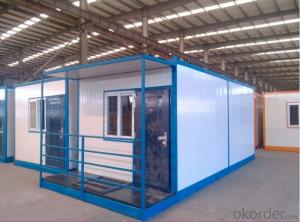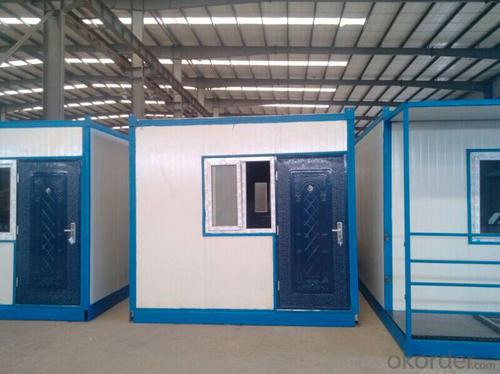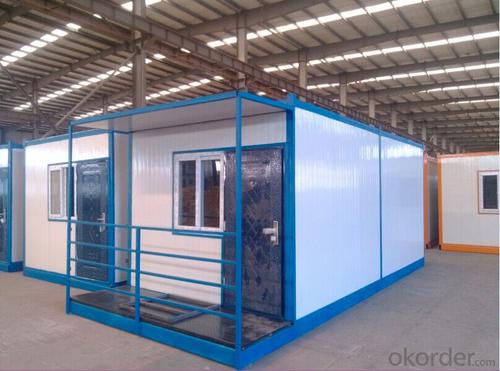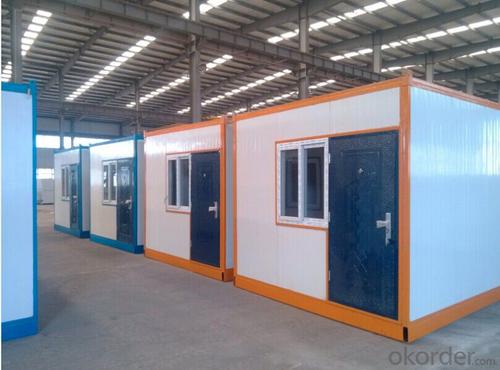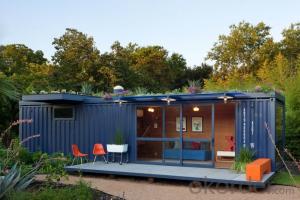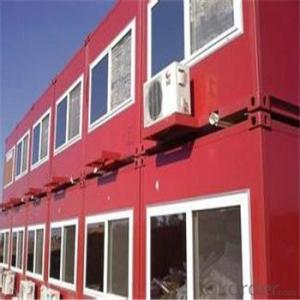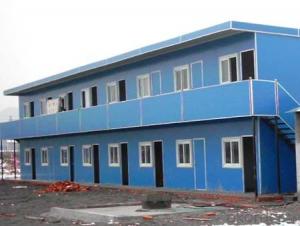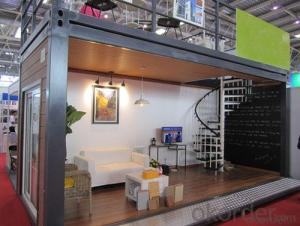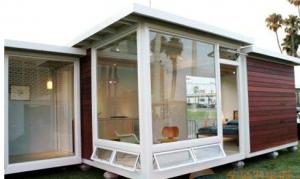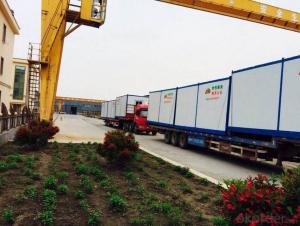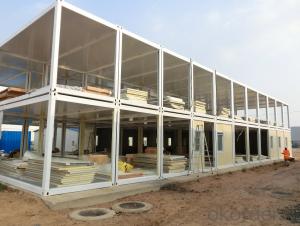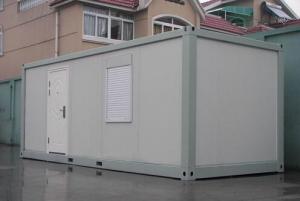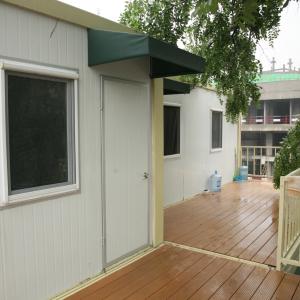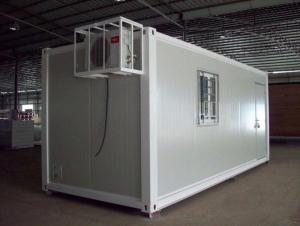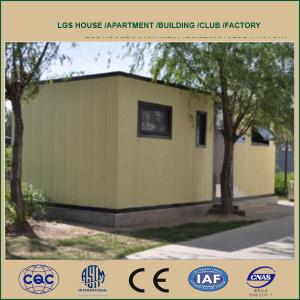Beijing Orient the constant integration activities chamber room
- Loading Port:
- Tianjin
- Payment Terms:
- TT OR LC
- Min Order Qty:
- 1 pc
- Supply Capability:
- 10000 pc/month
OKorder Service Pledge
OKorder Financial Service
You Might Also Like
Product introduction
The assembled series slope roof prefabricated houses
"Constant" brand series of slope roof assembled prefabricated houses is the company launched a new concept of environmental protection building economical activities, ordinary, standard and luxury type 3 kinds.According to customer demand, in a standard module for space combination, formed the skeleton system USES light steel structure, and to sandwich panels and PU tile forming palisade and roofing system.Realize the simple and beautiful, the construction fast, use safety, the standard of general overlay idea, make the overlay houses into an industrialized production, inventory, for repeated use of stereotypes housing products.
Sex can
Reliable structure: light steel system of flexible structure, safe and reliable, satisfies the requirement of building structure design codes.
Tear open outfit is convenient: housing can be repeatedly disassembling, repeated use.The installation process need only simple tools.Average per person per day to install 20-30 square meters, 6 people a team, 2 days to complete 3 k standard prefabricated houses 1 x 10 k.
Beautiful decoration: housing overall beautiful, bright color, texture soft, board face level off, have good adornment effect.
Flexible layout: doors and Windows can be installed in any position, interior partition can be set in any horizontal axis.The stairs set outside.
The structure of the building structure waterproof, waterproof design, does not need to do any other waterproof processing.
Long service life, light steel structure anticorrosion coating processing, normal service life can reach more than 10 years.
Environmental conservation: the reasonable design, easy tear open outfit, can be used many times cycle, low attrition rate, do not produce construction waste, the average annual cost is much lower than other materials of similar houses.
Using standardized components, a variety of specifications: building length and width are to K (1 K = 1820 mm) for the module.Transverse dimensions of mk + 160, the longitudinal size of nk + 160.
With the way
Are widely used in road, railway, construction and other field operation of temporary housing construction;Urban municipal, commercial and other temporary housing, such as: temporary office, conference room, headquarters, dormitory and temporary stores, temporary schools, temporary hospitals, temporary parking area, temporary exhibition hall, temporary filling stations, etc.
Assemble series flat roof prefabricated houses
"Constant" assembled series flat roof prefabricated housing is through making full use of their own strength of sandwich wall panel and roof panel, after pulling, bolts, self-tapping screw connection and finalize the design activities of housing system.Can be industrialized production, use, interior decoration, realize the inside and outside is beautiful, fast, safe construction overlay concept, tight sealing, heat insulation, waterproof, fireproof, moistureproof.
Aesthetically pleasing: housing overall modelling beautiful, inside and outside are color decorative plates, good appearance, design and colour collocation to coordinate.
Long use period: normal service life can reach more than 10 years.Convenient transportation, dismantling recycling, environmental savings.
With the way
Are widely used in road, railway, construction and other field operation of temporary housing construction;Urban municipal, commercial and other temporary housing.Such as: temporary office, conference room, headquarters, dormitory and temporary stores, temporary schools, temporary hospitals, temporary parking area, temporary exhibition hall, temporary maintenance, temporary transformer room, temporary filling stations, etc.Other temporary housing areas, such as military logistics temporary occupancy, rescue and relief temporary occupancy, sterile laboratories, isolation rooms, communication substation room.Scenic area of temporary use leisure villa, vacation homes, etc.
Products > > activity control box, the bathroom
Box is by utilizing sandwich wall panel and roof panel connection of their own strength, by screw, bolts, self-tapping screw, wall sandwich plate and the steel structure base housing system composed of roof plate connection.Quick construction, whole movable, especially suitable for municipal facilities and field construction site of the gatehouse, service, etc.
Toilet is mainly is made of light steel structure, caigang sandwich board maintenance material, to give expulsion-typely wastewater and circulating water storage (microbes) drainage way portable toilet.Can be very convenient to install, move, move, especially suitable for streets, sports venues, the use of tourist attractions.
Fence is made of steel structure column, double color sandwich steel or single color pressed steel by bolt connection and into.All of its components are composed of standard parts, the arbitrary assembly, short installation period, the effect is good, the color can be specially made according to the requirements.Repeatable tear open outfit, use, construction waste, beautiful appearance.
- Q: Can container houses be built with a contemporary retail store setup?
- Indeed, it is possible to construct container houses with a modern retail store arrangement. The popularity of container houses is on the rise due to their versatility, affordability, and sustainability. These dwellings can be tailored and personalized to suit various requirements, including the provision of retail areas. By making appropriate alterations and employing interior design techniques, containers can be converted into trendy and functional retail stores. The modular nature of containers allows for easy expansion or reconfiguration of the retail space as necessary. Furthermore, containers can be stacked or combined to create multi-level or larger retail layouts. Container houses can also be equipped with contemporary conveniences like sizable windows, glass doors, and climate control systems to offer customers an attractive and comfortable shopping experience. Interior design elements such as shelving, display cases, and lighting can be strategically integrated to enhance the aesthetic appeal of the retail space. Furthermore, container houses offer the advantage of mobility. If desired, the retail store arrangement can be effortlessly transported to a new location, providing flexibility for business owners. Containers can also be designed to be easily disassembled and reassembled, making it convenient to relocate or expand the retail space as the business expands. In conclusion, container houses can indeed be constructed with a contemporary retail store setup. They present a distinctive and innovative solution for businesses seeking economical, sustainable, and adaptable retail spaces.
- Q: Can container houses be designed to have a spacious bathroom?
- Yes, container houses can be designed to have a spacious bathroom. While container homes typically have limited space, clever design and utilization of the available area can create a spacious bathroom. By incorporating innovative storage solutions, efficient layouts, and utilizing the vertical space, container houses can provide a comfortable and roomy bathroom experience.
- Q: Are container houses suitable for co-living or shared housing?
- Co-living or shared housing is indeed a suitable option for container houses. These houses have various advantages for this type of living arrangement. To begin with, container houses can be easily customized and modified to accommodate multiple individuals or families. By utilizing the modular nature of container houses, separate living spaces can be created within the same structure, ensuring privacy and personal space for each resident. Additionally, container houses are cost-effective, making them an excellent choice for shared housing. Compared to traditional housing, the construction and maintenance costs of container houses are generally lower. This financial advantage can alleviate the burden on residents. Moreover, container houses are energy-efficient and can be equipped with sustainable features like solar panels, rainwater harvesting systems, and energy-efficient appliances. This not only reduces utility costs but also promotes an eco-friendly lifestyle. Furthermore, container houses offer flexibility in terms of location. They can be easily transported and set up in various areas, making it convenient for co-living communities to establish homes in urban or rural settings. This flexibility enables residents to select a location that best suits their needs, whether it is in proximity to their workplaces, educational institutions, or social amenities. Moreover, container houses foster a sense of community and shared responsibility. Living in close proximity encourages social interaction and collaboration among residents for tasks like maintaining common areas or organizing community events. This sense of community enhances the overall living experience and creates a supportive environment for co-living residents. In conclusion, container houses are an ideal choice for co-living or shared housing due to their flexibility, cost-effectiveness, and ability to create separate living spaces within a single structure. These houses offer a unique opportunity to build sustainable and affordable communities while fostering a sense of togetherness and providing the necessary privacy and personal space for each resident.
- Q: Can container houses be designed with a rooftop garden?
- Yes, container houses can be designed with a rooftop garden. The structure and versatility of container houses allow for the installation of a rooftop garden, which can provide additional green space, promote sustainability, and enhance the overall aesthetic of the house.
- Q: Can container houses be converted into offices or studios?
- Yes, container houses can certainly be converted into offices or studios. Due to their modular design and versatility, container houses can be easily transformed into functional workspaces or creative studios by adding insulation, windows, electrical wiring, and other necessary amenities. This adaptability, cost-effectiveness, and eco-friendly nature of container houses make them a popular choice for such conversions.
- Q: Can container houses be designed to have a fireplace?
- Container houses can indeed be designed with a fireplace. Despite the fact that containers are typically made of steel, which is not traditionally used for constructing fireplaces, there are methods to integrate a fireplace into a container house design. One common approach involves utilizing a wood-burning stove or a closed combustion fireplace, both of which can be installed within a specially designated area that permits proper ventilation and safety precautions. Furthermore, modifications can be made to the container to include a chimney or venting system, ensuring that smoke is safely directed outside. It is absolutely crucial to seek guidance from professionals well-versed in container home construction and fireplace installation. This will ensure that all necessary safety measures are adhered to and that the design aligns with local building codes and regulations.
- Q: Can container houses be designed with a separate entrance?
- Yes, container houses can definitely be designed with a separate entrance. In fact, one of the advantages of using shipping containers for housing is their versatility and adaptability. Architects and designers have found creative ways to modify containers to meet the specific needs and preferences of homeowners. When it comes to designing a container house with a separate entrance, there are several options to consider. One common approach is to connect multiple containers together, creating a larger living space with multiple entrances. This allows for the creation of separate entrances for different areas of the house, such as the main living area, bedrooms, or even home offices. Another option is to add an additional container specifically for the entrance. This container can be modified to include a foyer or entryway, providing a designated space for guests to enter the house. This can also be an opportunity to incorporate unique architectural features, such as large windows or a covered porch, creating an inviting entrance that enhances the overall aesthetic of the container house. Additionally, container houses can be designed with separate entrances by utilizing different levels or sections within the structure. This can be achieved by stacking containers vertically or arranging them in a way that allows for distinct access points. Overall, container houses offer great flexibility in design, making it entirely possible to incorporate a separate entrance into the overall layout. With the right creativity and planning, container houses can be customized to meet the specific needs and preferences of homeowners while still maintaining their unique and sustainable characteristics.
- Q: Can container houses be designed to blend with the surrounding environment?
- Yes, container houses can be designed to blend with the surrounding environment. By using materials, colors, and architectural techniques that complement the natural surroundings, container houses can seamlessly integrate into their environment, whether it is in an urban setting or a rural landscape. Additionally, landscaping and thoughtful placement of the containers can further enhance their visual appeal and harmonize with the surrounding environment.
- Q: Are container houses resistant to floods or water damage?
- Floods or water damage can be resisted by container houses if they are designed accordingly. Waterproofing and flood resistance can be achieved through the use of appropriate construction techniques and materials. The primary concern is to ensure the proper sealing of the containers and the implementation of effective water drainage systems. Furthermore, elevating the containers on a raised foundation or incorporating flood-resistant designs can provide an additional level of protection against flooding. It should be emphasized that the specific location and severity of the flood must also be taken into account when considering the flood resistance of container houses.
- Q: Are container houses suitable for art galleries?
- Art galleries can indeed find container houses to be a suitable option. The rising popularity of using shipping containers in architecture is due to their affordability and versatility. In the context of art galleries, container houses bring several advantages. First and foremost, the modular nature of shipping containers allows for easy customization and expansion. Artists and curators can stack, combine, or arrange containers in various configurations to create unique gallery layouts. This flexibility enables them to adapt the space according to their specific needs and artistic visions. Secondly, container houses are renowned for their durability. Designed to withstand harsh marine environments, shipping containers are structurally robust and weather-resistant. This characteristic ensures the protection of valuable artworks from potential damage caused by external elements like moisture, pests, or extreme temperatures. Furthermore, container houses offer an industrial and contemporary aesthetic that can complement and enhance the artwork displayed within. The raw, minimalistic design of containers creates a unique backdrop for various art styles, ranging from contemporary to avant-garde. Additionally, container houses are often more cost-effective compared to traditional building methods. The price per square foot for container construction is generally lower, allowing art galleries to allocate more resources towards promoting and acquiring artwork. However, certain considerations must be taken into account when using container houses as art galleries. Insulation and climate control are crucial factors in preserving delicate artworks. To ensure a stable environment, proper insulation and HVAC systems should be installed to control temperature and humidity within the gallery space. Additionally, adequate lighting and security measures should be implemented to effectively showcase the artwork and protect it from theft or damage. In conclusion, container houses present a suitable option for art galleries, offering versatility, durability, affordability, and a unique aesthetic. However, addressing insulation, climate control, lighting, and security is essential in creating an optimal environment for showcasing and preserving artworks.
Send your message to us
Beijing Orient the constant integration activities chamber room
- Loading Port:
- Tianjin
- Payment Terms:
- TT OR LC
- Min Order Qty:
- 1 pc
- Supply Capability:
- 10000 pc/month
OKorder Service Pledge
OKorder Financial Service
Similar products
Hot products
Hot Searches
Related keywords

